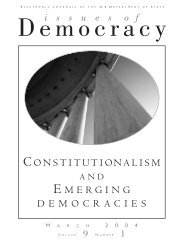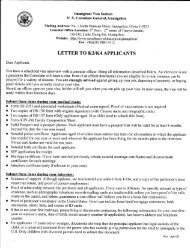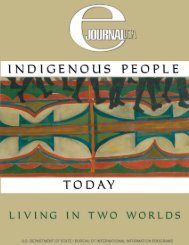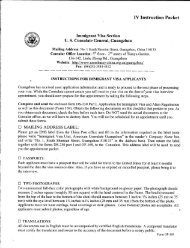s. history us history us history - Embassy of the United States
s. history us history us history - Embassy of the United States
s. history us history us history - Embassy of the United States
- No tags were found...
Create successful ePaper yourself
Turn your PDF publications into a flip-book with our unique Google optimized e-Paper software.
CHAPTER 8: GROWTH AND TRANSFORMATIONOUTLINE OF U.S. HISTORYwhelmingly agrarian, and economicallydependent. Moreover, its racerelations reflected not j<strong>us</strong>t <strong>the</strong> legacy<strong>of</strong> slavery, but what was emerging as<strong>the</strong> central <strong>the</strong>me <strong>of</strong> its <strong>history</strong> — adetermination to enforce white supremacyat any cost.Intransigent white Sou<strong>the</strong>rnersfound ways to assert state controlto maintain white dominance. SeveralSupreme Court decisions alsobolstered <strong>the</strong>ir efforts by upholdingtraditional Sou<strong>the</strong>rn views <strong>of</strong> <strong>the</strong> appropriatebalance between nationaland state power.In 1873 <strong>the</strong> Supreme Court foundthat <strong>the</strong> 14th Amendment (citizenshiprights not to be abridged)conferred no new privileges or immunitiesto protect African Americansfrom state power. In 1883,fur<strong>the</strong>rmore, it ruled that <strong>the</strong> 14thAmendment did not prevent individuals,as opposed to states, frompracticing discrimination. And inPlessy v. Ferg<strong>us</strong>on (1896), <strong>the</strong> Courtfound that “separate but equal”public accommodations for AfricanAmericans, such as trains andrestaurants, did not violate <strong>the</strong>irrights. Soon <strong>the</strong> principle <strong>of</strong> segregationby race extended into everyarea <strong>of</strong> Sou<strong>the</strong>rn life, from railroadsto restaurants, hotels, hospitals, andschools. Moreover, any area <strong>of</strong> lifethat was not segregated by law wassegregated by c<strong>us</strong>tom and practice.Fur<strong>the</strong>r curtailment <strong>of</strong> <strong>the</strong> right tovote followed. Periodic lynchingsby mobs underscored <strong>the</strong> region’sdetermination to subjugate its African-Americanpopulation.Faced with pervasive discrimination,many African Americans followedBooker T. Washington, whocounseled <strong>the</strong>m to foc<strong>us</strong> on modesteconomic goals and to accept temporarysocial discrimination. O<strong>the</strong>rs,led by <strong>the</strong> African-Americanintellectual W.E.B. Du Bois, wantedto challenge segregation throughpolitical action. But with both majorparties uninterested in <strong>the</strong> issueand scientific <strong>the</strong>ory <strong>of</strong> <strong>the</strong> timegenerally accepting black inferiority,calls for racial j<strong>us</strong>tice attractedlittle support.THE LAST FRONTIERIn 1865 <strong>the</strong> frontier line generallyfollowed <strong>the</strong> western limits <strong>of</strong> <strong>the</strong>states bordering <strong>the</strong> Mississippi River,but bulged outward beyond <strong>the</strong>eastern sections <strong>of</strong> Texas, Kansas,and Nebraska. Then, running northand south for nearly 1,600 kilometers,loomed huge mountain ranges,many rich in silver, gold, and o<strong>the</strong>rmetals. To <strong>the</strong>ir west, plains and desertsstretched to <strong>the</strong> wooded coastalranges and <strong>the</strong> Pacific Ocean. Apartfrom <strong>the</strong> settled districts in Californiaand scattered outposts, <strong>the</strong>vast inland region was populatedby Native Americans: among <strong>the</strong>m<strong>the</strong> Great Plains tribes — Sioux andBlackfoot, Pawnee and Cheyenne— and <strong>the</strong> Indian cultures <strong>of</strong> <strong>the</strong>Southwest, including Apache, Navajo,and Hopi.A mere quarter-century later,virtually all this country had beencarved into states and territories.Miners had ranged over <strong>the</strong> whole<strong>of</strong> <strong>the</strong> mountain country, tunnelinginto <strong>the</strong> earth, establishing littlecommunities in Nevada, Montana,and Colorado. Cattle ranchers,taking advantage <strong>of</strong> <strong>the</strong> enormo<strong>us</strong>grasslands, had laid claim to <strong>the</strong>huge expanse stretching from Texasto <strong>the</strong> upper Missouri River. Sheepherders had found <strong>the</strong>ir way to <strong>the</strong>valleys and mountain slopes. Farmerssank <strong>the</strong>ir plows into <strong>the</strong> plainsand closed <strong>the</strong> gap between <strong>the</strong> Eastand West. By 1890 <strong>the</strong> frontier linehad disappeared.Settlement was spurred by <strong>the</strong>Homestead Act <strong>of</strong> 1862, whichgranted free farms <strong>of</strong> 64 hectaresto citizens who would occupy andimprove <strong>the</strong> land. Unfortunatelyfor <strong>the</strong> would-be farmers, much <strong>of</strong><strong>the</strong> Great Plains was suited more forcattle ranching than farming, andby 1880 nearly 22,400,000 hectares<strong>of</strong> “free” land was in <strong>the</strong> hands <strong>of</strong>cattlemen or <strong>the</strong> railroads.In 1862 Congress also voted acharter to <strong>the</strong> Union Pacific Railroad,which p<strong>us</strong>hed westward fromCouncil Bluffs, Iowa, <strong>us</strong>ing mostly<strong>the</strong> labor <strong>of</strong> ex-soldiers and Irish immigrants.At <strong>the</strong> same time, <strong>the</strong> CentralPacific Railroad began to buildeastward from Sacramento, California,relying heavily on Chineseimmigrant labor. The whole countrywas stirred as <strong>the</strong> two lines steadilyapproached each o<strong>the</strong>r, finally meetingon May 10, 1869, at PromontoryPoint in Utah. The months <strong>of</strong> laborio<strong>us</strong>travel hi<strong>the</strong>rto separating <strong>the</strong>two oceans was now cut to about sixdays. The continental rail networkgrew steadily; by 1884 four greatlines linked <strong>the</strong> central MississippiValley area with <strong>the</strong> Pacific.The first great r<strong>us</strong>h <strong>of</strong> populationto <strong>the</strong> Far West was drawn to <strong>the</strong>mountaino<strong>us</strong> regions, where goldwas found in California in 1848,in Colorado and Nevada 10 yearslater, in Montana and Wyoming in<strong>the</strong> 1860s, and in <strong>the</strong> Black Hills <strong>of</strong><strong>the</strong> Dakota country in <strong>the</strong> 1870s.Miners opened up <strong>the</strong> country, establishedcommunities, and laid <strong>the</strong>foundations for more permanentsettlements. Eventually, however,though a few communities continuedto be devoted almost excl<strong>us</strong>ivelyto mining, <strong>the</strong> real wealth <strong>of</strong> Montana,Colorado, Wyoming, Idaho,and California proved to be in <strong>the</strong>grass and soil. Cattle-raising, longan important ind<strong>us</strong>try in Texas,flourished after <strong>the</strong> Civil War, whenenterprising men began to drive<strong>the</strong>ir Texas longhorn cattle northacross <strong>the</strong> open public land. Feedingas <strong>the</strong>y went, <strong>the</strong> cattle arrivedat railway shipping points in Kansas,larger and fatter than when <strong>the</strong>ystarted. The annual cattle drive becamea regular event; for hundreds<strong>of</strong> kilometers, trails were dotted withherds moving northward.Next, immense cattle ranchesappeared in Colorado, Wyoming,Kansas, Nebraska, and <strong>the</strong> Dakotaterritory. Western cities flourishedas centers for <strong>the</strong> slaughter anddressing <strong>of</strong> meat. The cattle boompeaked in <strong>the</strong> mid-1880s. By <strong>the</strong>n,not far behind <strong>the</strong> rancher creaked178179












